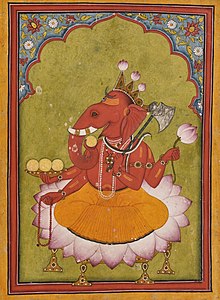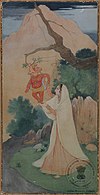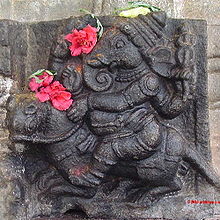
Varaha is the avatar of the Hindu god Vishnu, in the form of a boar. Varaha is generally listed as third in the Dashavatara, the ten principal avataras of Vishnu.

Kubera also known as Kuvera, Kuber and Kuberan, is the god of wealth, and the god-king of the semi-divine yakshas in Hinduism. He is regarded as the regent of the north (Dikpala), and a protector of the world (Lokapala). His many epithets extol him as the overlord of numerous semi-divine species, and the owner of the treasures of the world. Kubera is often depicted with a plump body, adorned with jewels, and carrying a money-pot and a club.
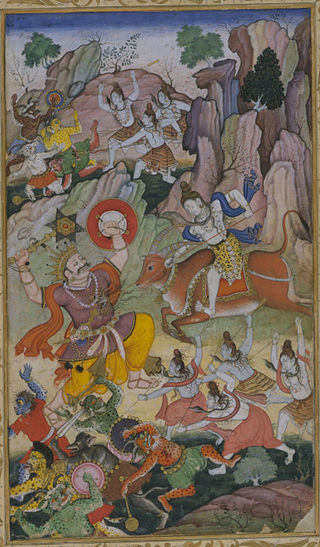
In Hindu literature, Andhaka refers to a malevolent asura, whose pride is vanquished by Shiva and Parvati.

Avatar is a concept within Hinduism that in Sanskrit literally means 'descent'. It signifies the material appearance or incarnation of a powerful deity, or spirit on Earth. The relative verb to "alight, to make one's appearance" is sometimes used to refer to any guru or revered human being.

Krishna Dvaipayana, better known as Vyasa or Vedavyasa, is a revered Rishi portrayed in most Hindu traditions. He is traditionally regarded as the author of the epic Mahābhārata.
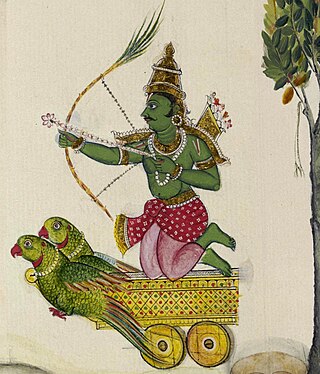
Kama, also known as Kamadeva and Manmatha, is the Hindu god of erotic love, desire, pleasure and beauty, often portrayed alongside his consort and female counterpart, Rati. He is depicted as a handsome young man decked with ornaments and flowers, armed with a bow of sugarcane and shooting arrows of flowers.

Mohini is the Hindu goddess of enchantment. She is the only female avatar of the Hindu god Vishnu. She is portrayed as a femme fatale, an enchantress, who maddens lovers and demons, sometimes leading them to their doom. Mohini is introduced into Hinduism in the narrative epic of the Mahabharata. Here, she appears as a form of Vishnu following the Churning of the Ocean, a mesmerising beauty who distributes the amrita to the weakened devas (gods) and depriving it to the dominant asuras (demons), allowing the former to defeat the latter with their newfound immortality.

Ganapatya is a denomination of Hinduism that worships Ganesha as the Saguna Brahman.

The Sritattvanidhi is a treatise written in the 19th century in Karnataka on the iconography and iconometry of divine figures in South India. One of its sections includes instructions for, and illustrations of, 122 hatha yoga postures.

Ganesha is a prominent Hindu god. He is the god of Beginnings, Wisdom and Luck and worshipped as the Remover of Obstacles. Ganesha is easily recognized from his elephant head. Devotion to Ganesha is widely diffused and extends to Jains and Buddhists and beyond India.
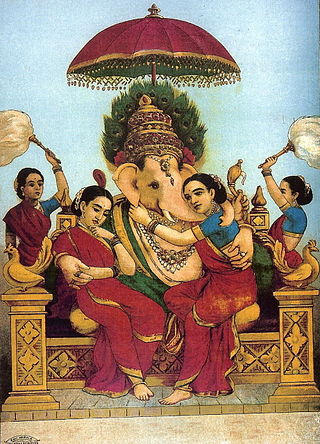
The marital status of Ganesha varies widely in mythological stories and the issue has been the subject of considerable scholarly review. Several patterns of associations with different consorts are identifiable. One pattern of myths identifies Ganesha as an unmarried brahmacārin with no consorts. Another mainstream pattern associates him with the concepts of Buddhi (intellect), Siddhi, and Riddhi (prosperity); these qualities are sometimes personified as goddesses who are considered to be Ganesha's wives. Another pattern connects Ganesha with the goddess of culture and the arts, Sarasvati. In the Bengal region he is linked with the banana tree, Kala Bo. Usually Ganesha's consort is portrayed as his shakti, a personification of his creative energy.

Heramba, also known as Heramba Ganapati, is a five-headed iconographical form of the Hindu god Ganesha (Ganapati). This form is particularly popular in Nepal. This form is important in Tantric worship of Ganesha. He is one of the most popular of the thirty-two forms of Ganesha.

Shuka is a rishi (sage) in Hinduism. He is the son of the sage Vyasa and the main narrator of the scripture Bhagavata Purana. Most of the Bhagavata Purana consists of Shuka reciting the story to the king Parikshit in his final days. Shuka is depicted as a sannyasi, renouncing the world in pursuit of moksha (liberation), which most narratives assert that he achieved.

Ganesha, also spelled Ganesh, and also known as Ganapati, Vinayaka, and Pillaiyar, is one of the best-known and most worshipped deities in the Hindu pantheon and is the Supreme God in the Ganapatya sect. His depictions are found throughout India. Hindu denominations worship him regardless of affiliations. Devotion to Ganesha is widely diffused and extends to Jains and Buddhists and beyond India.

Shri Mayureshwar Mandir or Shri Moreshwar Temple is a Hindu temple (mandir) dedicated to Ganesha, god of wisdom. It is located in Moragaon in Pune District, about 65 km away from Pune city in the Indian state of Maharashtra. The temple is the starting and ending point of a pilgrimage of eight revered Ganesha temples called Ashtavinayaka.
Tarakasura is a powerful asura in Hindu mythology. He is the son of the asura Vajranga and his wife Vajrangi. Taraka had three sons: Tarakaksha, Vidyunmali, and Kamalaksha, who were known as the Tripurasura. He is slain by Kartikeya.

The Siddhivinayak Temple of Siddhatek is a Hindu temple dedicated to Ganesha, the elephant-headed god of wisdom. The temple is one of the Ashtavinayaka, the eight revered shrines of Ganesha in the Indian state of Maharashtra and the only Ashtavinayaka shrine in Ahmednagar district.

Vinayaki (Vināyakī) is an elephant-headed Hindu goddess. Her mythology and iconography are not clearly defined. Little is told about her in Hindu scriptures and very few images of this deity exist.

Bala Ganapati is an aspect of the Hindu god Ganesha (Ganapati), the elephant-headed of wisdom and fortune, depicted as a child.
